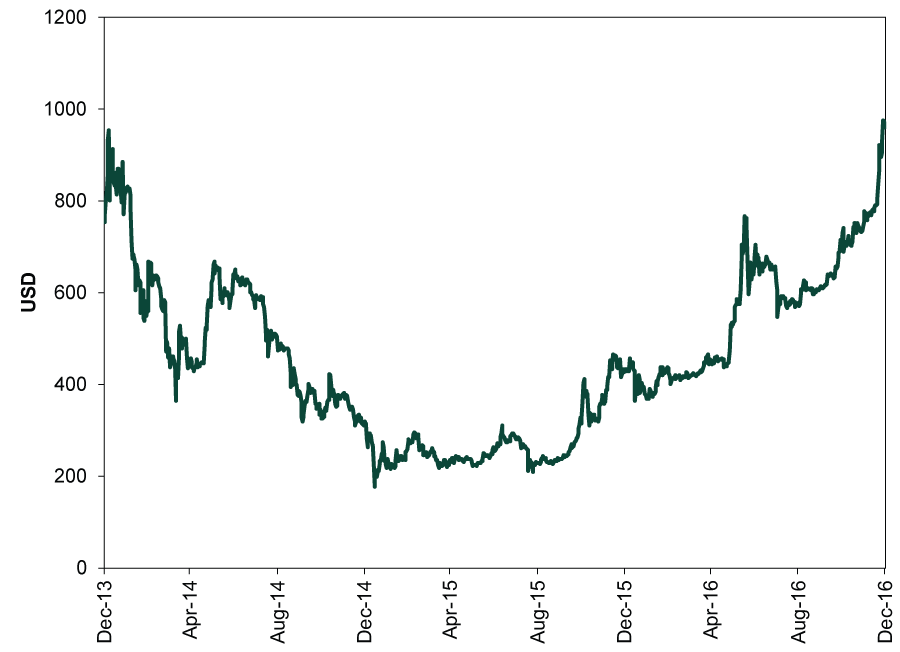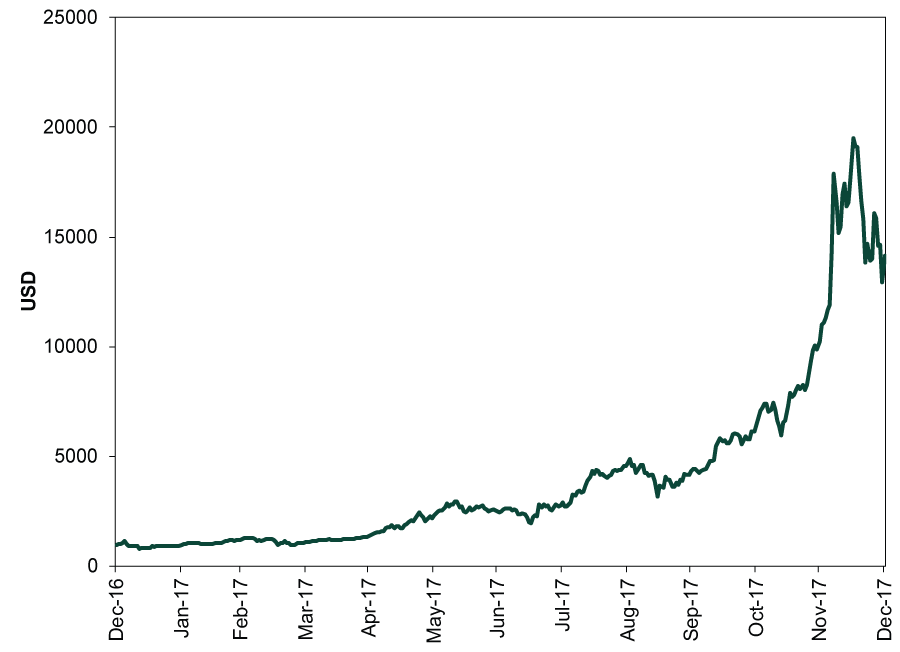Personal Wealth Management / Market Analysis
Anatomy of a Bubble: Bitcoin Edition
The bitcoin bubble illustrates what true euphoria looks like—and why it isn’t dead.
Don Ho once sang tiny bubbles made him happy.[i] I humbly offer this investing corollary: Euphoric investors can make assets bubbly. Our case study today: the bitcoin bubble. We are more than a year removed from bitcoin’s peak, giving us a nice snapshot of what bubble behavior looks like. Bitcoin (and its ilk) went from the Next Big Thing with the potential to solve global poverty to being dropped from CBOE futures trading recently because so few people cared anymore. Its story holds several lessons for long-term investors.
The Anatomy of a Bubble
Financial media use the term “bubble” liberally, but rising prices alone do not a bubble make. In a global bull market, different sectors and countries lead (and trail), and certain segments can get frothy. Think biotech back in 2014 or mainland Chinese stocks in 2015. However, the broad market generally rises overall and over time during a global bull.
A true bubble looks different. Prices surge exponentially, driven primarily by hype. Bitcoin, which has existed for a decade, illustrates this well. Excluding some fleeting mainstream attention in 2013,[ii] bitcoin’s biggest proponents hung out in the outer rim of the mainstream investment universe—think extreme anarcholibertarians or criminals. After bottoming in 2015, bitcoin prices steadily rose, and the general crypto space got more attention from both media and regular investors. Gradually warming sentiment then exploded in 2017.
Between 2013 and 2016, bitcoin’s price bounced from as low as $178 to as high as $975—a median of $432 during that stretch.[iii] In 2017 alone, bitcoin’s price skyrocketed from $998 on January 1 to $19,497 on December 16.[iv] Those of us in the financial industry endured a cornucopia of questions like “what we thought of cryptocurrencies” and “what about bitcoin” over Thanksgiving. (Not that we minded the questions or talking about this stuff, but their ubiquity was telling.)
Here are some charts for visual learners. Pay special attention to the Y-axis.
Exhibit 1: Bitcoin’s Price, 2013 — 2016

Source: CoinMarketCap, as of 4/10/2019. Bitcoin price in USD, 12/31/2013 – 12/31/2016.
Exhibit 1 reflects three years’ price movement. Here is 2017’s—just one year. Again, mind the Y-axis.
Exhibit 2: Bitcoin’s Price, 2017

Source: CoinMarketCap, as of 4/10/2019. Bitcoin price in USD, 12/31/2016 – 12/31/2017.
If you cut away the jargon and gobbledygook, cryptocurrencies’ ostensible raison d’être—to be a currency like the US dollar—didn’t change. But investor sentiment did—and rapidly. That euphoria is the key ingredient of an asset bubble.
What Euphoria Looks Like
Tracking sentiment is more art than science, as quantifying human emotion is a tall order. However, rampant euphoria can manifest itself in noticeable ways. Think of the proverbial “taxi cab driver or barber offering stock tips” anecdote. Back in late 2017, when cryptocurrency “experts”[v] dominated airwaves, you may have had conversations with friends who couldn’t stop bragging about their latest cryptocurrency buy. My colleague Elisabeth Dellinger’s prescient column, “You Might Be Near a Crypto-Top If…” nicely highlights many of these examples.
This behavior is common near a bubble’s peak. In December 2017, a famous bitcoin advocate predicted it would reach $1 million by the end of 2020. At the time, it hadn’t even reached $20,000. That harkens back to the last true stock market bubble in 1999 — 2000, when predictions of “Dow 36,000” (at the time, it just broke 11,000) received widespread, serious attention. Euphoria blinds investors into extrapolating dazzling returns ad infinitum. Many try to explain why “it’s different this time”—the four most dangerous words in investing, as history can attest.
Hindsight Is Always Keenest
Bubbles look obvious in hindsight, but they aren’t easy to spot in the moment. Several months after the Tech Bubble popped in March 2000, one manager kept the faith, comparing his fund to a one-time phenomenal-then-disgraced professional athlete, saying, “We’re Tiger Woods. … We’ve gone six months without winning a tournament.”[vi] Similarly, weeks after bitcoin’s peak in December 2017, the mainstream press was still running profiles about the top cryptocurrencies to watch in 2018. We can assess the damage only after the fall—which was spectacular in bitcoin’s case. Since its December 16, 2017 peak of $19,497, bitcoin has plunged. It appeared to bottom on December 15, 2018, at $3,236—about -83.4% off that high.[vii]
Today, we hear nary a peep about bitcoin or its cryptocurrency brethren, save for the occasional grave dancing or excitement over a recent pop—the latter a sign at least some crypto enthusiasm may yet linger. However, accumulating pride from bitcoin’s demise seems like the wrong takeaway. Instead, the bitcoin bubble is a telling window into true euphoria, which can be instructive for investors. For one, it is a reminder of euphoria’s absence in this long bull market. Folks are deeply dour, despite global stocks being only a few percentage points from all-time highs. Euphoria also hasn’t taken hold in global equity markets for nearly two decades. Some may have forgotten what a real bubble looks like. Others have posited euphoria is dead, and sentiment has a new normal. Yet there is nothing new under the sun. As Fisher Investments’ founder and Executive Chairman Ken Fisher wrote in his 2006 book, The Only Three Questions That Count, one of the most important exercises investors can do is to ask themselves, “What is my brain doing to trick me now?” Thinking asset bubbles and euphoria are extinct is one of those tricks. Bitcoin’s story is proof.[i] Though those bubbles came from his wine, not soap.
[ii] Which went poof due to the big Mt. Gox hack, which roiled confidence.
[iii] Source: CoinMarketCap.com, as of 4/10/2019. Bitcoin price in USD, 12/31/2013 – 12/31/2016.
[iv] Ibid. Bitcoin price in USD, 1/1/2017 – 12/16/2017.
[v] Thought experiment: How can one be an “expert” in something with no real history or fundamental drivers? Semi-relatedly, is Twitter’s “verification” blue checkmark a sign of expertise?
[vi] Source: “Mutual Funds Report; Where Else to Gaze When a Star Falls to Earth?” by Danny Hakim, The New York Times, 10/8/2000.
[vii] Source: CoinMarketCap.com, as of 4/10/2019. Bitcoin’s price as of 4/9/2019: $5,204.96.
If you would like to contact the editors responsible for this article, please message MarketMinder directly.
*The content contained in this article represents only the opinions and viewpoints of the Fisher Investments editorial staff.
Get a weekly roundup of our market insights
Sign up for our weekly e-mail newsletter.

You Imagine Your Future. We Help You Get There.
Are you ready to start your journey to a better financial future?

Where Might the Market Go Next?
Confidently tackle the market’s ups and downs with independent research and analysis that tells you where we think stocks are headed—and why.





